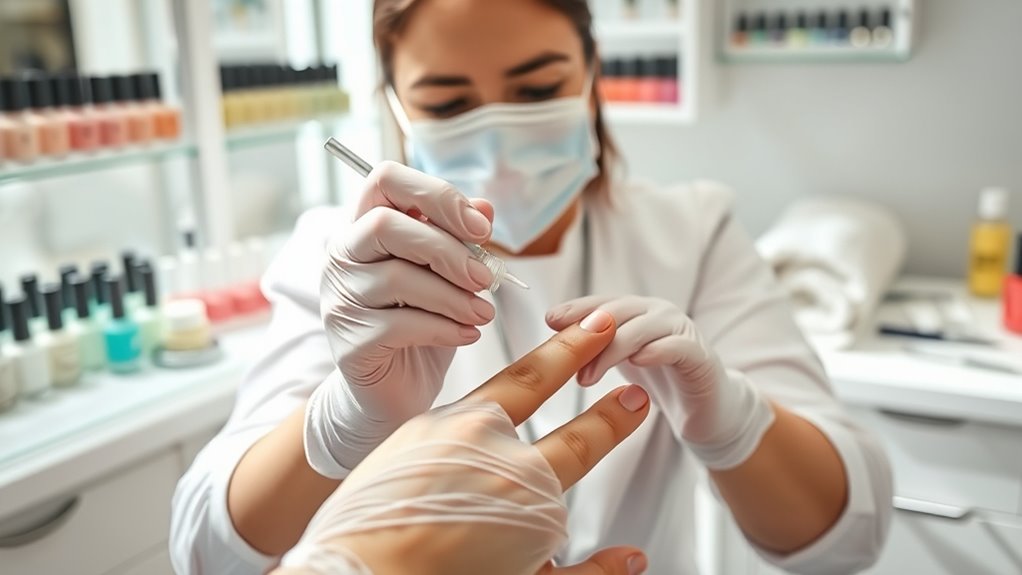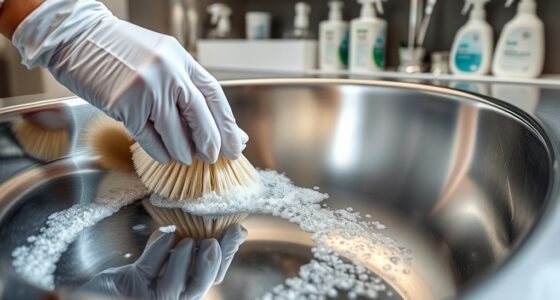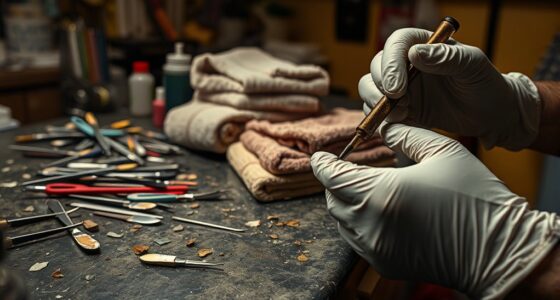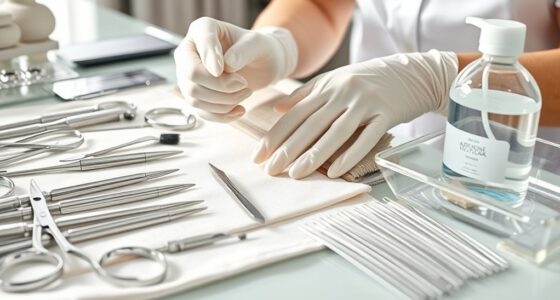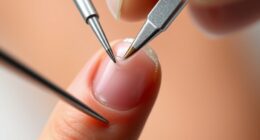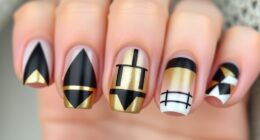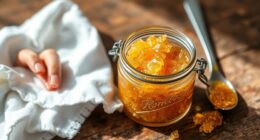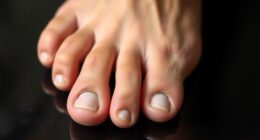If you get a cut, nick, or accident during a manicure, stay calm and wash your hands with soap and warm water. Gently apply pressure with a clean cloth or gauze to stop bleeding, then disinfect the area with an antiseptic. Cover the wound with a sterile bandage and keep it clean. Watch for signs of infection, and if you want to learn more tips on safe aftercare, keep exploring how to handle salon mishaps effectively.
Key Takeaways
- Stay calm, clean the wound with soap and water, and disinfect with alcohol or antiseptic.
- Apply gentle pressure with a sterile cloth to stop bleeding.
- Cover the cut with a sterile bandage and keep it protected from dirt.
- Monitor for signs of infection like redness, swelling, or pus, and seek medical help if needed.
- Choose salons with proper hygiene practices and bring personal disinfected tools when possible.
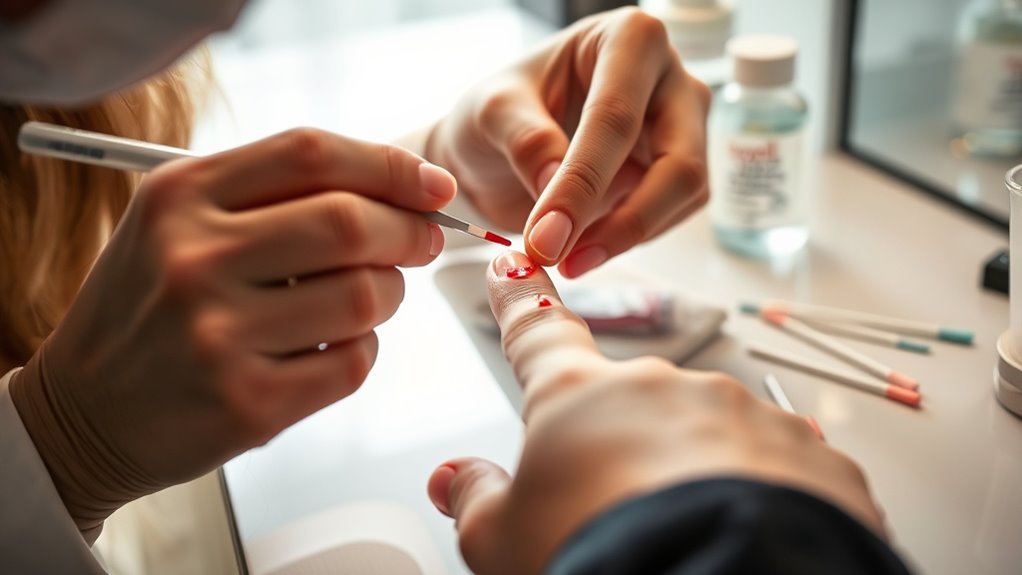
Have you ever wondered what to do if a nail salon mishap occurs? It’s a common concern, especially when it comes to maintaining manicure safety and salon hygiene. Accidents like cuts, nicks, or small injuries can happen unexpectedly, but knowing how to respond quickly and effectively can prevent infection and minimize discomfort. First, stay calm and assess the situation. If you notice a tiny cut or nick from a nail tool or file, the key is to act swiftly to prevent bacteria from entering the wound.
Start by washing your hands thoroughly with soap and warm water. This step is essential because it helps eliminate any germs or debris that might have come into contact with the injury. If the salon doesn’t seem to prioritize salon hygiene, you might want to be extra cautious and use your own disinfected tools or ask the technician to clean their equipment properly before continuing. After washing, gently pat the area dry with a clean towel or gauze. Applying pressure with a sterile cloth or cotton ball can help stop bleeding if necessary. Use gentle, steady pressure—don’t press too hard, as that could worsen the injury.
Wash your hands thoroughly, dry gently, and apply steady pressure to control bleeding.
Once bleeding is controlled, applying an antiseptic is critical. Use an alcohol wipe, hydrogen peroxide, or an antiseptic ointment to disinfect the wound. This step is fundamental because it reduces the risk of infection, especially in environments where salon hygiene might sometimes be subpar. Cover the cut with a sterile bandage or adhesive strip to keep it protected from dirt and bacteria. If the injury is minor, this simple step can prevent complications and keep you comfortable.
Additionally, ensuring your environment is clean and sanitized can further reduce infection risks. Keep a close eye on the wound over the next few days. If you notice increased redness, swelling, pus, or if the pain worsens, don’t hesitate to seek medical attention. These signs could indicate an infection that requires professional treatment. Remember, proper aftercare is essential for manicure safety, so avoid picking at the scab or exposing the wound to unclean surfaces.
Preventing future mishaps involves choosing salons that prioritize salon hygiene and follow strict safety protocols. Don’t be shy about bringing your own tools or asking questions about their sterilization procedures. Being proactive ensures you’re protecting yourself from unnecessary risks. Quick and proper first aid not only minimizes discomfort but also helps maintain your health and confidence during every manicure session.
Frequently Asked Questions
What Should I Do if a Chemical Burns My Skin?
If a chemical burns your skin, act quickly to minimize damage. Rinse the affected area with cool, running water for at least 15 minutes to remove the chemical and promote skin protection. Avoid using ice or creams. After rinsing, gently pat dry and cover with a clean, sterile bandage. Seek medical attention immediately, especially if the burn is severe or blistered. Quick action helps reduce pain and prevent further injury.
How Can I Prevent Infections After a Nail Accident?
Think of preventing infections after a nail accident as sealing a tiny fortress. You should immediately clean the wound gently with antiseptic application to eliminate germs. Then, cover it with a sterile wound dressing to keep contaminants out. Changing the dressing regularly guarantees ongoing protection. By acting quickly and carefully, you create a barrier that shields your skin from infection, helping it heal smoothly and safely.
What Tools Are Best for Sanitizing Salon First Aid Supplies?
You should use UV sterilizers and alcohol wipes to sanitize salon first aid supplies effectively. UV sterilizers kill bacteria and viruses on tools like scissors and tweezers quickly and thoroughly, ensuring they’re safe for reuse. Alcohol wipes are excellent for cleaning smaller items, such as nail files or buffers, before and after use. Combining these methods helps maintain a clean environment, reducing infection risks and keeping your salon safe for clients.
How Long Should I Monitor a Minor Nail Injury?
Think of monitoring a minor nail injury as tending a delicate garden—you need to keep a watchful eye. You should observe the wound for at least 15 minutes, ensuring it stays clean and free of infection signs. During this time, check for excessive bleeding, redness, or swelling. If the injury remains stable and wound cleanliness is maintained, you can be confident it’s healing properly. Always follow up if anything worsens.
When Should I Seek Professional Medical Help for Nail Injuries?
You should seek professional consultation if your nail injury shows signs of infection, severe pain, or if bleeding doesn’t stop after applying pressure. Emergency recognition is vital if you notice deep cuts, exposed tissue, or if the injury results from a heavy object. When in doubt, don’t hesitate to visit a healthcare professional to guarantee proper treatment and prevent complications. Your prompt action can make all the difference in healing.
Conclusion
So, next time you accidentally turn a simple manicure into a DIY horror show, remember that a quick first aid fix can save the day—and your reputation. Because nothing says “professional” like wielding antiseptic like a superhero and turning a minor cut into a badge of honor. After all, who needs a first aid kit when you’ve got a steady hand and a sense of humor? Keep calm, carry on, and pretend it’s all part of the charm.
